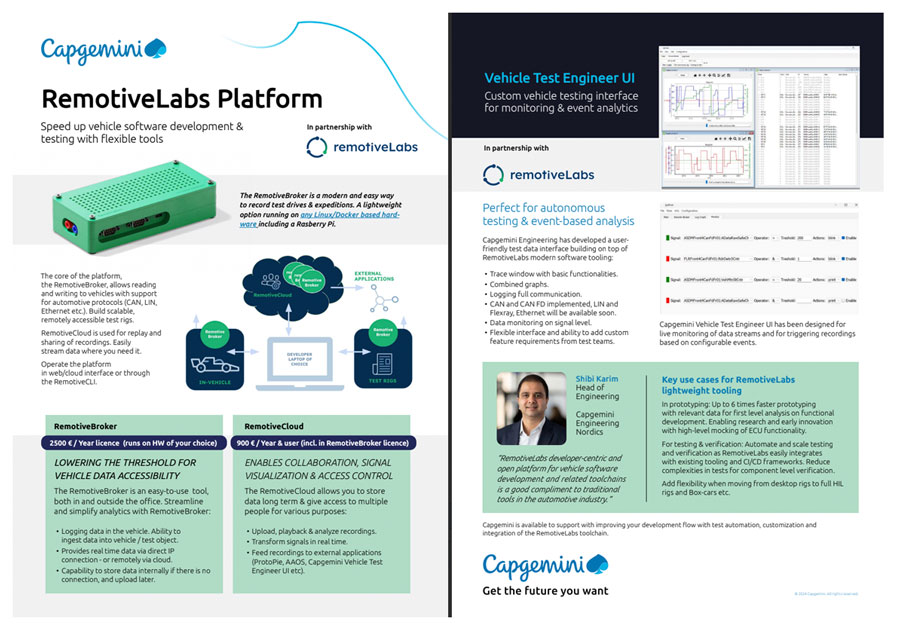Capgemini Engineering has realized the potential in bringing open and developer-centric tooling to their automotive customers. Interview with Haiko Steitzer, Product Owner & Solution manager, & Jonatan Svensson, Software Engineer, on how and why Capgemini is bringing RemotiveLabs tooling to vehicle software engineering and testing teams.
Capgemini Engineering utilizes the RemotiveLabs Platform for increased prototyping speed plus building scalable and flexible test rigs. The tooling is not only substantially more cost-efficient compared to traditional tooling in automotive, it also unlocks new and modern ways of working. The team has seen an increased need of modern tooling including a user interface for vehicle test engineers. We interviewed Haiko Steitzer and Jonatan Svensson on why traditional vehicle test tooling is not catering well to Capgemini’s customers, what use cases they see and what differences there are with RemotiveLabs vs traditional tooling.

Open the 2-page Tech Sheet:
– Overview of RemotiveLabs tooling including pricing
– Intro to Capgemini Vehicle Test Engineer UI

Haiko Steitzer,
Product Owner & Solution manager
Capgemini Engineering
Haiko: Tools that have been around since CAN and other networks were first introduced to vehicles have always been very tailored. OEMs had their own solutions for logging data and the established tools are very inflexible and heavy to work with. For example, CANoe is quite a beast if you want to configure something. You have to physically go to the vehicle and have domain specific knowledge. The tools are also very expensive, both in license models and that they are tied to specific hardware. With RemotiveLabs tooling, Capgemini Engineering can offer our customers a unified, flexible, and reasonably priced solution without hardware dependencies.

Jonatan Svensson,
Software Engineer
Capgemini Engineering
Jonatan: My background is in general programming, and I find the industry specific tooling in automotive cumbersome to work with. Different versions on different vehicles are making them not compatible and it literally becomes a mess supporting customers! When building the Capgemini Vehicle Test Engineer UI, we found the process quite intuitive – in RemotiveLabs platform it is for example agnostic to where the information is coming from – it is easy to connect to the RemotiveBroker via Wi-Fi or Ethernet, making development quite easy!
“Having common automotive tools
Haiko Steitzer, Product Owner, Capgemini Engineering
between brands and models will help
reduce complexity of daily work tasks”
Jonatan: It started with use cases in an existing project for autonomous tests. If you don’t know when something will break or occur – we needed an application to efficiently log and share a specific incident for debugging. We decided to build the first prototype of a Test Engineer UI, with a similar visual representation as existing tools, but built it on top of RemotiveLabs open platform. We did a first prototype and then continued adding features from there. The “old tools of automotive” were not created with autonomous solutions in mind and we see a lot of potential for continued development of this UI.
The RemotiveBroker is designed to be developer friendly and one of the main ways of interacting with the broker is with the gRPC API. This API gives you full control over the broker i.e. it allows you to subscribe to /publish signals, inspect metadata from a signal database, playback recordings and more.
gRPC have broad language support and is very efficient thanks to its binary message format Learn more>>
Haiko: With our Vehicle Test Engineer UI solution, we want to lower the threshold for engineers to become more self-serving in capturing, collaborating, and working efficiently with vehicle data. There are huge amounts of data continuously coming from vehicles today, it needs to become easier for a test engineer to find a specific scenario or occurrence in the vehicle to capture.

Jonatan: Interoperable tooling provides flexibility to help our customers enhance their prototyping or testing capabilities in whatever way they need it – and with the great advantage that developers understand the tools intuitively; they don’t need to speak “old automotive”.
“The open and documented interface
Jonatan Svensson, Software Engineer Capgemini Engineering
makes life easier in comparison to proprietary interfaces
/ APIs where you have to live with the given format”.
Haiko: A main use case I see is simpler field tests. We’ve had enough with the time of huge breakout boxes with all the connectors, wires, and tailored setups. It is a time-consuming work with huge potential for mechanical failure! The RemotiveBroker is a much more robust and simple way to connect to the vehicle, with signals available remotely if you have a connection. We also see use cases during validation to reuse logs in an emulator or partly simulated environment. Our customers will appreciate the easier ways to send new signals that are not yet officially available as a way to prototype more easily. There are many reasons for our customers – including the significantly more affordable price tag to scale availability of vehicle OEMs to left-shift their development, and we are here to guide them.